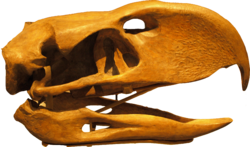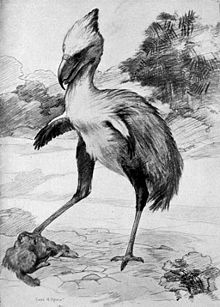- Phorusrhacos
-
Phorusrhacos
Temporal range: Early Miocene–Mid Miocene
Reconstructed skull on display at the Royal Ontario Museum, Toronto Scientific classification Kingdom: Animalia Phylum: Chordata Class: Aves Order: Cariamae Family: Phorusrhacidae Genus: Phorusrhacos
Ameghino, 1887Species: P. longissimus Binomial name Phorusrhacos longissimus
Ameghino, 1887Synonyms see text
Phorusrhacos (pronounced "FOR-rus-RAH-kos") ("Rag-Thief", from Greek φώρ, thief, + ῤάκος, rag.[1]) was a genus of giant flightless predatory birds that lived in Patagonia, containing the single species Phorusrhacos longissimus. Their closest living relatives are the much smaller seriema birds. The terror birds lived in woodlands and grasslands.
Contents
Discovery and description
 Restoration by Charles R. Knight
Restoration by Charles R. Knight
Among the bones found in the stratum of the Santa Cruz Formation (now considered as mainly of mid-Miocene date) was the piece of a mandible which Florentino Ameghino (1887) at first described as that of an edentate mammal. In 1891, it was recognized to be a bird. Remains are known from several localities in the Santa Cruz Province, of Argentina.
Phorusrhacos stood around 2.5 meters (8 ft) tall and weighed approximately 130 kilograms (280 lbs) (Alvarenga & Höfling, 2003). It was nicknamed the "Terror Bird" for obvious reasons: it was one of the largest carnivorous birds to have ever existed, along with Titanis, Kelenken and Brontornis, and its rudimentary wings formed arm-like structures with claws shaped like a meat hook for tackling prey, which was then killed with the massive beak. It ate small mammals and carrion. It is speculated in the Discovery Channel series "Monsters Resurrected" that the bird killed in two ways. First by grasping its prey with its beak and smashing it to the ground repeatedly like its modern relatives, the seriemas. Secondly, and more dramatically, by striking downward with the sharp downward spike at the front of its upper beak. If in the right position, the series speculated, the spike could penetrate the braincase and kill instantly. It had an enormous skull up to sixty centimeters long, armed with a powerful, hook-tipped beak. The structure of the beak and the large claws on the toes show that this was a bird of prey. It raced over the grassy plateaus and hills of Patagonia, catching small reptiles and mammals and leaving larger prey to its far more massive relatives such as Brontornis.
Synonyms
Phorusrhacos longissimus and its genus have been described under a number of synonyms:
Genus-level synonymy:
- Phorusrhacos Ameghino, 1887 (see Anonymous, 1992)
- Phororhacos Ameghino, 1889
- Mesembriornis Moreno, 1889
- Stereornis Moreno & Mercerat, 1891
- Darwinornis Moreno & Mercerat, 1891
- Owenornis Moreno & Mercerat, 1891
- Titanornis Mercerat, 1893
- Callornis Ameghino, 1895
- Liornis Ameghino, 1895
- Eucallornis Ameghino, 1901
Species-level synonymy:
- Phororhacos longissimus Ameghino, 1889
- Stereornis rollieri Moreno & Mercerat, 1891
- Stereornis gaundryi Moreno & Mercerat, 1891
- Mesembriornis studeri Moreno & Mercerat, 1891
- Mesembriornis quatrefragesi Moreno & Mercerat, 1891
- Darwinornis copei Moreno & Mercerat, 1891
- Darwinornis zittelli Moreno & Mercerat, 1891
- Darwinornis socialis Moreno & Mercerat, 1891
- Owenornis affinis Moreno & Mercerat, 1891
- Owenornis lydekkeri Moreno & Mercerat, 1891
- Phororhacos sehuensis Ameghino, 1891
- Phororhacos platygnathus Ameghino, 1891
- Titanornis mirabilis Mercerat, 1893
- Callornis giganteus Ameghino, 1895
- Liornis floweri Ameghino, 1895
- Eucallornis giganteus Ameghino, 1901
- Liornis minor Dolgopol de Saez, 1927
The species Phororhacos inflatus, however, has been re-classified into the genus Patagornis.
Footnotes
References
 This article incorporates text from a publication now in the public domain: Chisholm, Hugh, ed (1911). Encyclopædia Britannica (11th ed.). Cambridge University Press.
This article incorporates text from a publication now in the public domain: Chisholm, Hugh, ed (1911). Encyclopædia Britannica (11th ed.). Cambridge University Press.
- Alvarenga, Herculano M. F. & Höfling, Elizabeth (2003): Systematic revision of the Phorusrhacidae (Aves: Ralliformes). Papéis Avulsos de Zoologia 43(4): 55-91 PDF fulltext
- Ameghino, Florentino (1887): Enumeración sistemática de las espécies de mamíferos fósiles coleccionados por Carlos Ameghino en los terrenos Eocenos de la Patagonia austral y depositados en el Museo de La Plata. Boletin del Museo de La Plata 1: 1-26. [Article in Spanish]
- Ameghino, Florentino (1889): Contribución al conocimiento de los mamíferos fósiles de la República Argentina. Actas Academia Nacional Ciencias de Córdoba 6: 1-1028. [Article in Spanish]
- Anonymous (1992): Opinion 1687. Phorusrhacos Ameghino, 1887 (Aves, Gruiformes): not suppressed. Bulletin of Zoological Nomenclature 49(2)
Categories:- Extinct flightless birds
- Genera of birds
- Miocene birds
- Phorusrhacinae
- Miocene extinctions
Wikimedia Foundation. 2010.
